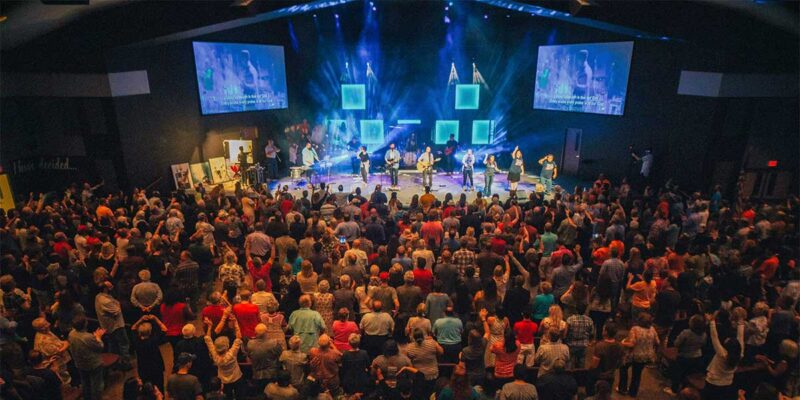Church AV: What You May Not Know About the House of Worship Market
 The house of worship market is comprised of many church sizes and venue types ranging from portable temporary set-up and tear-down weekly venues to gargantuan giga-churches with tens of thousands of attendees every weekend… and pretty much everything in between. Selling to such a wide variety of client types even with the same market space requires a familiarization of the various church venues, budgets and applications. It’s a bit dizzying for those unfamiliar with the dynamic nature of this vertical market.
The house of worship market is comprised of many church sizes and venue types ranging from portable temporary set-up and tear-down weekly venues to gargantuan giga-churches with tens of thousands of attendees every weekend… and pretty much everything in between. Selling to such a wide variety of client types even with the same market space requires a familiarization of the various church venues, budgets and applications. It’s a bit dizzying for those unfamiliar with the dynamic nature of this vertical market.
To help rAVe readers sell to this underserved market, we’ve included some helpful definitions and observations to help audiovisual (AVL) vendors know how to address and position products to this diverse market.
Multisite Churches
Sure, churches buildings have been around for ages, but the idea of having more than one church building for Sunday/weekend services is a fairly new idea, thanks entirely to audio and video technology that allows for simulcast or video playback from one venue to multiple others (hence the term ‘multi-site’).
Back in the 1990s, there were less than 200 multi-site churches. In 2019, that number is now estimated to be nearly 20,000 churches (with more than one location). The remarkable growth in the multisite church is directly proportional to the availability of affordable AVL technology. It is not a stretch to suggest that multisite video campuses have been the biggest trend in the church market since electronic sound reinforcement. In fact, one study (from back in 2012) revealed that there are now over 5,000 multisite churches in the United States, with some unofficial estimates pushing closer to 10,000 multisite churches.
Portable Churches
For churches looking to reach people in areas far from their main campus, the idea of launching portable churches — which are actually comprised of trailers full of technology being wheeled in and out of temporary venues for the day — has taken root and is often lower-cost/lower-risk strategy.
Set-up, tear-down churches meeting in retail spaces and even strip-center malls make up over 20 percent of all new churches in the United States. A “portable church” is a local congregation without a permanent facility, and often meets with the help of volunteers for setup and tear-down in venues such as schools, movie theaters and community centers. Technology is a major factor in these churches and the market is ripe for innovation and focused marketing efforts on behalf of manufacturers and systems integrators.
Church Plants
A growing number of churches are also spreading their influence without new multisite campuses. Instead, they’re opting to launch or “plant” new churches from within their own congregation. Unlike the multisite churches where the same message and shared resources are part of a single church, church plants are often sent out to create a new church that is independent of the original church.
These new church plants have a far better success rate than newly launched businesses here in the United States, with 99 percent of church plants surviving the first year, 92 percent the second year, 81 percent the third year and 68 percent the fourth year. That’s above the average of new businesses that make it to year five.
Church Budgets
Here’s another useful bit of data that can help give context to the question of how much budgets are for AVL technical systems in new construction projects. It’s not uncommon to see 8% of the total budget allotted to provide a rudimentary AVL system, 12% to 15% percent of the total new construction budget to provide a solid system and 20-22 percent of the total budget to build a technically-savvy venue. So for a $1 million new building campaign, anywhere from $80,000 (rudimentary) to $220,000 (technically savvy) can be budgeted for the technical systems alone.
Even though technology budgets vary greatly from church to church, it’s safe to apply 5-10 percent of the A/V/L system cost (if budgeted correctly using the above three averages) as yearly operations and maintenance dollar amounts. So if a church spends $150,000 on your AVL system, then anywhere from $7,500-$15,000 per year can easily be spent making sure the systems continue to perform without incident.
Church Attendance
The breakdown of churches by size is less about the real estate or seating capacity in churches and is instead typically measured in weekend attendance, as expressed by the term “Typical Weekly Attendance” (TWA). Here are some helpful stats when it comes to this key stat in the United States:
- 16% of churches report <100 weekly attendance
- 45% of churches have 100-500 in attendance
- 16% of churches have 500-999 attendance
- 21% of churches have attendance greater than 1,000+
Nearly 14,000 churches average between 500 attendees and 1,800 attendees each weekend, which is in addition to another 3,000 churches that average over 2,000 in weekly attendance. Even more staggering is the fact that half of the weekend attendance at churches in the US happens at only 10% of the overall church market.
Church Venue Sizes
Though attendance may report one number, the number of seats is not proportional to the number of attendees. For example, the trend of utilizing medium-sized to mid-sized venues (500 seats to about 750 seats) has spiked due to the lower costs to build and maintain smaller venues with fewer staff and volunteers needed to facilitate events. In addition, the opportunity to repurpose the space for other events that are not swallowed up by the enormity of a mega venue is a strong draw of many new church construction projects for these medium-sized venues, even if it requires multiple services per weekend to accommodate the volume of attendees.
While the dynamics of churches vary greatly, the common opportunity for both manufacturers and AV systems integrators is to leverage technology to fit into any and all of these various variables, as churches are heavily reliant upon AVL technology.
Share your views and opinions in the comments below.





